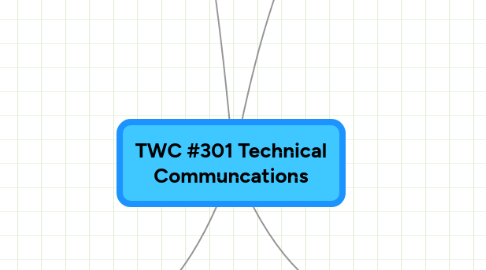
1. Characteristics of TC CH1
1.1. Rhetorical - persuade to act
1.1.1. http://rhetoric.byu.edu/encompassing%20terms/rhetoric.htm
1.1.2. http://rhetoric.byu.edu/Pedagogy/Rhetorical%20Analysis%20heuristic.htm
1.1.3. http://www.paradigmpublishers.com/resrcs/other/1594510857_otherlink2.pdf
1.1.4. http://apcentral.collegeboard.com/apc/members/courses/teachers_corner/32181.html
1.2. Audience centered - understand and address needs of particular audience
1.2.1. Transnational Audience
1.2.1.1. Language - target & official
1.2.1.2. Education-literacy rate, Common knowledge, Learning style
1.2.1.3. Politica & Law-trade & legal issues, political traditions & symbols
1.2.1.4. Economics -xchng rates, product value & service
1.2.1.5. Society - etiquette, social norms
1.2.1.6. Religion
1.2.1.7. HTW - Global Communication p228
1.3. Technology Oriented - multimedia environment
1.3.1. HTW-Conducting Mtgs Remotely p 324
1.3.2. HTW- Presentations p391
1.3.3. HTW- Wikis for Collaborative Writing p.72
1.3.4. Transnational - technology similar?
1.4. Ethical
1.4.1. http://managementhelp.org/ethics/ethxgde.htm
1.4.2. http://www.stc.org/intercom/PDFs/2009/200904_04-08.pdf pages 2-5
1.5. Research Oriented - dictated by purpose of document being produced
1.6. Professional - accessible, correct conventions, form & content, formal tone, informative
1.6.1. Transnational
1.6.1.1. Terminology
1.6.1.2. Clarity
1.6.1.3. Cultural /rhetorical differences
1.6.1.4. Localization, I18N, Globalization
1.6.1.5. HTW - Int'l Correspondence p265
1.6.1.6. HTW - Biased Language p47
1.7. Visual - increase clarity & meaning
1.7.1. HTW - Visuals p 552
1.8. Design Centered - document architecture - layout
1.8.1. Transnational - text R2L? & style
1.9. Concise - efficient, "healthy" statements
1.9.1. Transnational - clearly & localized
2. Problem Solving - PSA - understanding situation and strategy to solve
2.1. Plan
2.1.1. Define Problem
2.1.2. Establish goals
2.1.3. Audience?
2.1.4. Ethics
2.1.5. Document format and delivery
2.1.6. Info have & need
2.1.7. technologies used & delivery
2.2. Research
2.2.1. Info needed & acquiring
2.2.2. Conduct research and gather info
2.2.3. Organize info
2.2.4. Evaluate - qty & quality
2.3. Draft
2.3.1. Confirm goals, delivery & format
2.3.2. Organize & draft
2.3.3. Design & Arrange
2.3.4. Add Visuals
2.4. Review
2.4.1. Test usability
2.4.2. Solicit feedback
2.4.3. Revise/Rewrite
2.4.4. Edit chk for correctness
2.5. Distribute
2.5.1. Attachments
2.5.2. Delivery
2.5.3. Confirm recp't
2.5.4. Successful?
3. Genres of TC- CH1
3.1. E-mails/memos
3.2. Job Search Docs
3.3. Letters
3.4. Technical Defns & Descriptions
3.5. Websites
3.5.1. HTW Web: writing p570/Design p561
3.6. Tech Instructions & Manuals
3.7. Proposals
3.7.1. HTW Proposals p412
3.8. Reports
3.8.1. HTW Reports p454
3.9. Presentations
4. Activities of Professional writing Ch1
4.1. Planning
4.2. Researching
4.3. Organizing
4.4. Drafting
4.4.1. Pre-Drafting Strategies
4.4.1.1. Confirm purpose
4.4.1.2. Analyze Audience
4.4.1.3. Gather Info
4.4.1.4. Organize Info
4.4.1.4.1. sequential
4.4.1.4.2. chronological
4.4.1.4.3. order of importance
4.4.1.4.4. general vs specific
4.4.1.4.5. division into subcomponents
4.4.1.4.6. classification
4.4.1.4.7. cause & effect
4.4.1.4.8. comparison/contrast
4.4.1.4.9. spatial/w/ or w/out visuals
4.4.1.4.10. HTW - Methods of Development p329
4.4.2. Writing the Draft
4.4.2.1. Parts of the Document
4.4.2.1.1. Front/Introductory Information - title,cover image, date, byline, table of contents, exec summary, materials/parts lsist, addressed, defn's, alerts & warnings, Introduction
4.4.2.1.2. Body - core information, procedure, data, steps
4.4.2.1.3. End matter - conclusions, suggestions, final analysis - indexes/appendixes, glossaries, contact & follow-up info
4.4.2.2. Non-linear process
4.4.2.3. Drafting Body - 1st part written- complete coverage, organization
4.4.2.4. Drafting conclusion - summary, predictions, recommendations, judgements
4.4.2.5. Drafting Intro - Purpose/Objective, Scope, statement problem, bkgrnd info, organization overview, summary
